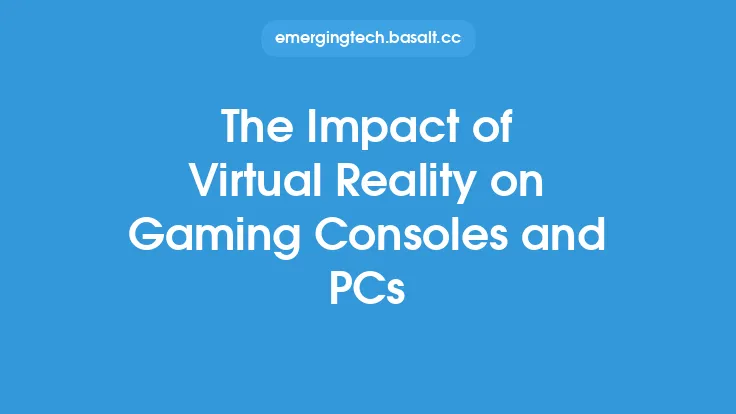The world of gaming has undergone a significant transformation in recent years, with the advent of virtual reality (VR) technology. This innovative technology has taken the gaming experience to new heights, providing players with a level of immersion that was previously unimaginable. With VR, gamers can step into the virtual world and become an integral part of the game, surrounded by stunning visuals, realistic sound effects, and intuitive controls.
Introduction to Virtual Reality Gaming
Virtual reality gaming is a type of gaming that uses a headset or other device to provide a fully immersive experience. The headset tracks the player's head movements, allowing them to look around and interact with the virtual environment in a natural way. This technology has been around for several decades, but it wasn't until the release of the Oculus Rift in 2016 that VR gaming started to gain mainstream attention. Since then, other companies such as HTC, Valve, and Sony have released their own VR headsets, each with its own unique features and capabilities.
Key Components of Virtual Reality Gaming
There are several key components that make up a VR gaming system. The first is the headset, which is the device that the player wears on their head to experience the virtual world. The headset typically contains a high-resolution display, sensors to track the player's head movements, and lenses to focus the image. The next component is the computer or console, which is the device that runs the game and generates the virtual world. This can be a high-end gaming PC or a console such as the PlayStation 4. The final component is the controllers, which are used to interact with the virtual world. These can be handheld devices, such as the Oculus Touch controllers, or more advanced systems, such as the Valve Index controllers, which use hand tracking technology to allow players to use their hands in the virtual world.
Types of Virtual Reality Games
There are several types of VR games, each with its own unique characteristics and gameplay mechanics. One of the most popular types of VR games is the first-person shooter, which allows players to experience the thrill of combat in a fully immersive environment. Other popular types of VR games include adventure games, puzzle games, and simulation games. Adventure games, such as "Myst" and "The Witness," challenge players to solve puzzles and explore a virtual world. Puzzle games, such as "Tetris" and "Portal," require players to use problem-solving skills to progress through the game. Simulation games, such as "Microsoft Flight Simulator" and "Euro Truck Simulator 2," allow players to experience realistic simulations of real-world activities.
Technical Requirements for Virtual Reality Gaming
To play VR games, players need a powerful computer or console that can handle the demanding graphics and processing requirements of VR technology. The minimum technical requirements for VR gaming include a high-end graphics card, a fast processor, and a large amount of memory. The graphics card is responsible for rendering the virtual world, and a high-end card is necessary to provide a smooth and realistic experience. The processor is responsible for handling the game's physics and logic, and a fast processor is necessary to prevent lag and stuttering. The amount of memory is also important, as it determines how much data the computer can store and process at any given time.
Advantages of Virtual Reality Gaming
There are several advantages to VR gaming, including increased immersion, improved engagement, and enhanced realism. The immersive nature of VR gaming allows players to become fully engaged in the game, surrounded by stunning visuals and realistic sound effects. The interactive nature of VR gaming also improves engagement, as players can use intuitive controls to interact with the virtual world. The realistic graphics and physics of VR gaming also enhance the overall gaming experience, providing a level of realism that is not possible with traditional gaming.
Challenges and Limitations of Virtual Reality Gaming
Despite the many advantages of VR gaming, there are also several challenges and limitations. One of the main challenges is the cost, as high-end VR headsets and computers can be expensive. Another challenge is the complexity, as VR gaming requires a significant amount of technical expertise to set up and use. The limited content is also a challenge, as there are still relatively few VR games available, and many of them are limited to specific genres or platforms. The health and safety concerns are also a limitation, as VR gaming can cause eye strain, headaches, and other health problems if not used properly.
Future of Virtual Reality Gaming
The future of VR gaming is exciting and rapidly evolving. As the technology continues to improve, we can expect to see more advanced graphics, more realistic physics, and more intuitive controls. The development of new VR headsets, such as the Oculus Quest and the Valve Index, is also expected to drive growth and innovation in the VR gaming industry. The increasing popularity of VR gaming is also expected to drive the development of new VR games, including more complex and realistic simulations, as well as more interactive and engaging experiences.
Conclusion
In conclusion, virtual reality gaming is a rapidly evolving field that is providing new and innovative ways for players to experience games. With its immersive graphics, interactive controls, and realistic physics, VR gaming is taking the gaming experience to new heights. While there are still several challenges and limitations to VR gaming, the future of this technology is exciting and rapidly evolving. As the technology continues to improve, we can expect to see more advanced graphics, more realistic physics, and more intuitive controls, providing a level of immersion and engagement that is not possible with traditional gaming.





